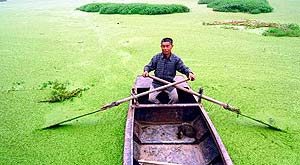China's war against pollution a daunting task
Xinhua, March 6, 2014 Adjust font size:
For Meng Lanzhi, founder of Hebei Tianzhu Iron and Steel (Group) Co. Ltd., smog is not just a health risk. It's also bad for business.
"If smog reaches a serious level and the government initiates an emergency response, my plant has to cut half its production capacity," said Meng, 65, a farmer-turned-businesswoman and also a deputy to the National People's Congress (NPC), China's top legislature.
"That means we have to produce 5,000 tonnes less steel every day," said Meng, board chairwoman of the private steel manufacturer with 6,200 staff based in the port city of Tangshan in north China's Hebei Province.
Premier Li Keqiang on Wednesday described smog as "nature's red-light warning against the model of inefficient and blind development," and said China will "declare war" on pollution.
Three decades of rapid industrialization and urbanization have brought wealth to millions of people like Meng in China. But the development has also caused severe environmental consequences such as smog, which in turn affects Chinese businesses.
Meng's business currently only makes minimal profits because the price of steel has dropped due to overcapacity and sluggish demand. Yet she spent 100 million yuan (16.3 million U.S. dollars) last year on sewage treatment to meet the environmental standard set up by the municipal government.
What's more, she is expected to invest another 200 million yuan to install equipment for coal gas reclaiming, dust cleaning and steam power generation to meet the government's tough standards on pollutant discharge.
Tangshan plans to reduce the density of PM2.5, a key indicator of air pollution, by about 33 percent from 2012 levels by the year 2017. It also plans to cut iron production capacity by 28 million tonnes and steel production capacity by 40 million tonnes, also by 2017.
On the national scale, China plans to cut steel production capacity by 80 million tonnes by 2017, 75 percent of which lies in Hebei Province.
So far, Meng has not received notification from the Tangshan municipal government to reduce capacity, but she already feels the pressure and has taken the initiative to improve her plant's discharge standards.
Environmental protection technologies for steel production are not mature in China, so Meng is perplexed about what kinds of equipment to procure.
Meng said environmental protection authorities should provide more information and services on equipment procurement in addition to their supervision efforts.
For smaller steel makers like Tangjia Iron and Steel Company, a private company with an annual production capacity of 1 million tonnes in Tangshan, the chances of survival are tougher.
The company is among 308 pollutant discharging companies designated by the Tangshan municipal government to be shut down or reduce capacity in 2013 for failing to meet environmental standards.
Two of the company's five production lines have been ordered to be shut down, which will affect hundreds of workers' lives.
Reducing steel production capacity by the 40 million tonnes designated by the municipal government -- almost one-third of the city's total capacity -- will involve the resettlement of more than 400,000 people directly or indirectly engaged in the industry, according to Jiang Deguo, secretary of the Tangshan Municipal Committee of the Communist Party of China.
The government faces the pressing task of fostering new areas of growth to keep people employed.
UNITED, OVERALL SOLUTION
Smog caused by a GDP-obsessed growth model and massive illegal discharges has covered almost all provinces and municipalities in east China, said Qin Dahe, an academician of the Chinese Academy of Sciences.
"The unpleasant air pollution control has exposed the problem of management," said Qin, former head of China Meteorological Administration.
Qin called for the establishment of an effective trans-regional pollution control mechanism that can give early smog and pollution warnings and dynamically regulate emissions, he said.
The evaluation system for government and Party officials' performance, once focused mainly on GDP, must also be changed to hold local officials accountable for environmental damages, said Ai Nanshan, a professor at Sichuan University in southwest China's Chengdu City.
Efforts should also be made to eliminate outdated energy producers and industrial plants, which are the major source of air pollution, said Chen Guoying, head of the Hebei Provincial Environmental Protection Department.
China will cut outdated steel production capacity by a total of 27 million tonnes this year, slash cement production by 42 million tonnes and also shut down 50,000 small coal-fired furnaces across the country, according to the government work report delivered by Premier Li on Wednesday.
"The former path of high consumption and pollution and low profits has come to an end," said Yu Yong, head of the Hebei Provincial Metallurgical Industry Association.
Cutting capacity is bound to lead to enterprise closures, said Wang Chang, an NPC deputy and head of the Hebei Provincial Industry and Information Technology Department.
The government will prompt enterprise mergers and reorganization to produce big enterprises that will adopt the latest equipment in new factories, said Wang.
The industrial land saved from the mergers can be used to develop urban commerce, which the surplus workers can engage in to earn a living, he said.
"The resettlement of workers, debts and financing are problems the government has to face in its industrial upgrade and battle against pollution," said Chen.
"I hope the central government can give Hebei some special preferential policies," said Chen.
The saturated markets and fierce competition have also forced enterprises to transform.
Tangshan Iron and Steel Co., Ltd., the largest iron and steel producer in the city, is aiming at non-steel sectors for survival.
Since 2010, 16,000 workers, nearly half of the company's total payroll, have been resettled in 22 non-steel affiliated companies in LED manufacturing, logistics, information automation and liquefied natural gas.


